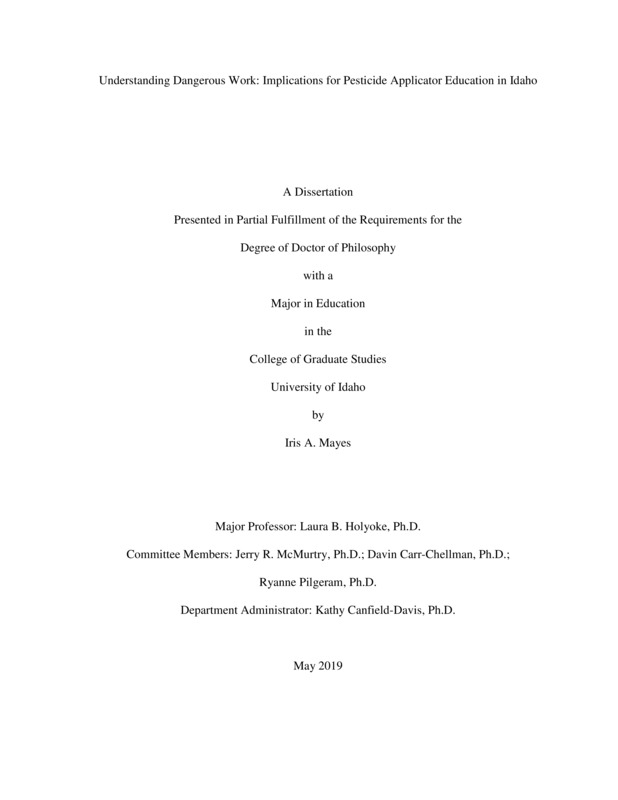Understanding Dangerous Work: Implications for Pesticide Applicator Education In Idaho
Mayes, Iris A. (2019-05). Understanding Dangerous Work: Implications for Pesticide Applicator Education In Idaho. Theses and Dissertations Collection, University of Idaho Library Digital Collections. https://www.lib.uidaho.edu/digital/etd/items/mayes_idaho_0089e_11601.html
- Title:
- Understanding Dangerous Work: Implications for Pesticide Applicator Education In Idaho
- Author:
- Mayes, Iris A
- ORCID:
- 0000-0003-0278-8447
- Date:
- 2019-05
- Keywords:
- narrative pesticide qualitative safety subculture worker
- Program:
- Curriculum & Instruction
- Subject Category:
- Adult education; Agriculture education; Vocational education
- Abstract:
-
Abstract
This document presents the findings of a qualitative, grounded theory research study on pesticide worker safety education and learning. A variety of factors contribute to the reasons pesticide applicators are not always fully engaged in the education required for them to practice their work safely, resulting in long-term health and environmental risks. The purpose of this study was to identify critical learning components and approaches that lead to the safe use of pesticides, mainly in large-scale agriculture.
Background. Approximately 8,000 licensed applicators in the state of Idaho apply pesticides on approximately 12,000 farms (NASS, USDA, 2017), roadways, parks and other types of landscaping. Pesticide use is highly regulated by federal and state government because of the potential significant and toxic effects if misused. It is well documented that pesticide accidents and drift occurrences can affect the health of workers and others who are inadvertently exposed to these potentially dangerous chemicals.
In 2017, I conducted a pilot study to gather data about work and educational practices for pesticide application in Idaho. The pilot study, a form of theoretical sampling, applied adult learning theory as a foundation for a priori themes, in concert with grounded theory to explore emergent data and categories. The study revealed four categories relevant to pesticide applicator safety training: knowledge and learning, worker practices, worker beliefs and attitudes, and work environment. The study was expanded in 2018 to include prior results and to develop a conceptual model of pesticide applicator safety in Idaho.
Methods. This study employed four focus group interviews with 24 pesticide applicators intended to elicit stories and effective learning mechanisms for pesticide safety. The study also included ten one-on-one interviews with experts to reach theoretical saturation of data categories, and also included a statewide survey of pesticide applicators to gather baseline data about the population of pesticide applicators in Idaho. Researcher observation was valuable in understanding the cultural context of pesticide applicators. Using grounded theory constant comparative method, data was coded through an iterative process in various stages: initial hand coding, open coding, incident coding, focused coding, and axial coding
Results. In addition to categories that surfaced from theoretical sampling: knowledge and learning, worker practices, worker beliefs and attitudes, and work environment, four additional categories arose from the data: changes over time, worker development, interfacing with the public, and dangerous work. Data also illuminated pesticide applicator subculture by clarifying that narrative, in the form of exposure and non-exposure stories, plays an integral role in learning.
Conclusions. Understanding the reasons pesticide applicators may take risks is key to developing effective safety training. The pilot study found that these reasons are embedded in the culture of the workforce, demonstrating the need to develop additional safety education programming that arises from the needs and motivations of pesticide applicators. Providing these workers access to research-based information may reduce risk, and training that utilizes narrative can serve to reinforce learning by providing an educational context. Of further interest is development of self-efficacy among pesticide applicators that could increase their safety and the safety of their co-workers. These findings offer a positive direction in development of future educational curriculum for pesticide applicators. Multiple topics call for further research. A conceptual model reveals forces that contextualize and contribute to the current pesticide safety education situation.
Keywords: pesticide safety education, subculture, worker learning, Idaho qualitative study, narrative
- Description:
- doctoral, Ph.D., Curriculum & Instruction -- University of Idaho - College of Graduate Studies, 2019-05
- Major Professor:
- Holyoke, Laura
- Committee:
- McMurtry, Jerry; Carr-Chelman, Davin; Pilgeram, Ryanne
- Defense Date:
- 2019-05
- Identifier:
- Mayes_idaho_0089E_11601
- Type:
- Text
- Format Original:
- Format:
- application/pdf
- Rights:
- In Copyright - Educational Use Permitted. For more information, please contact University of Idaho Library Special Collections and Archives Department at libspec@uidaho.edu.
- Standardized Rights:
- http://rightsstatements.org/vocab/InC-EDU/1.0/

